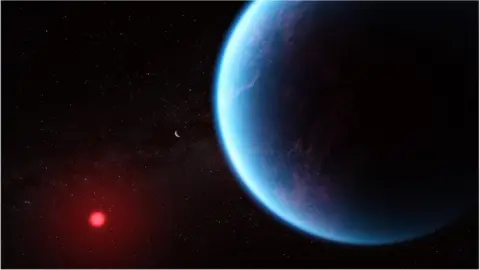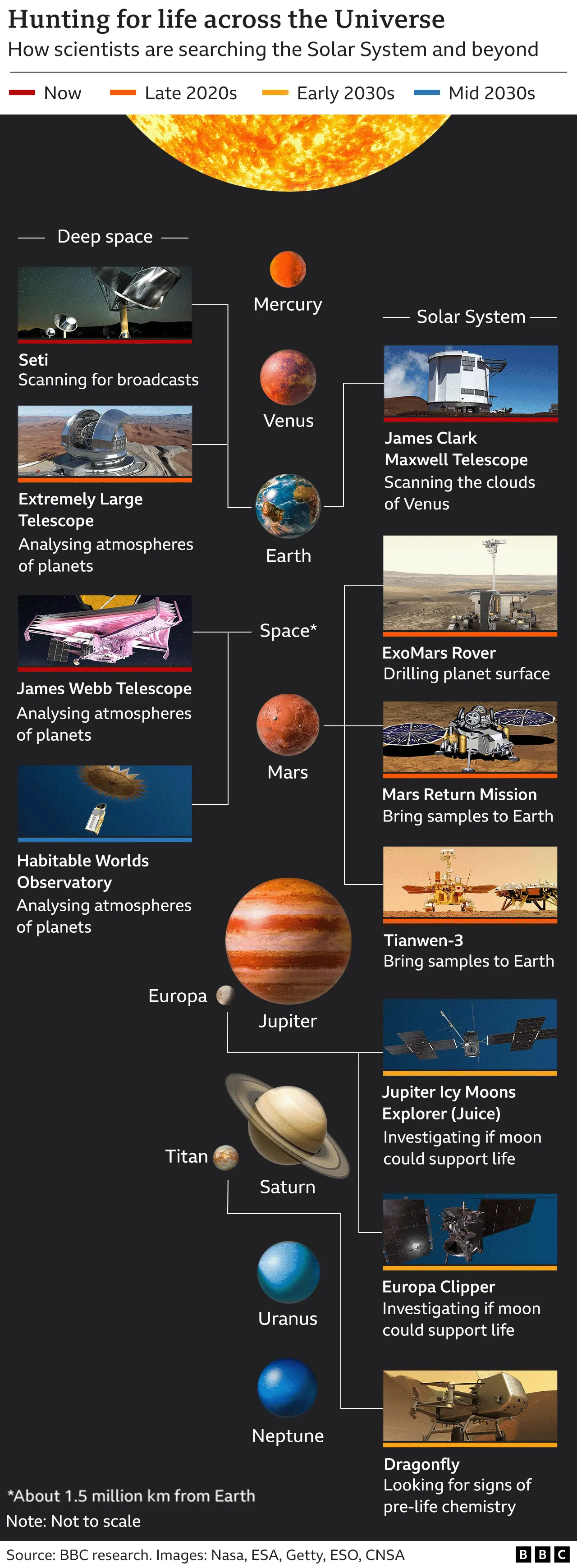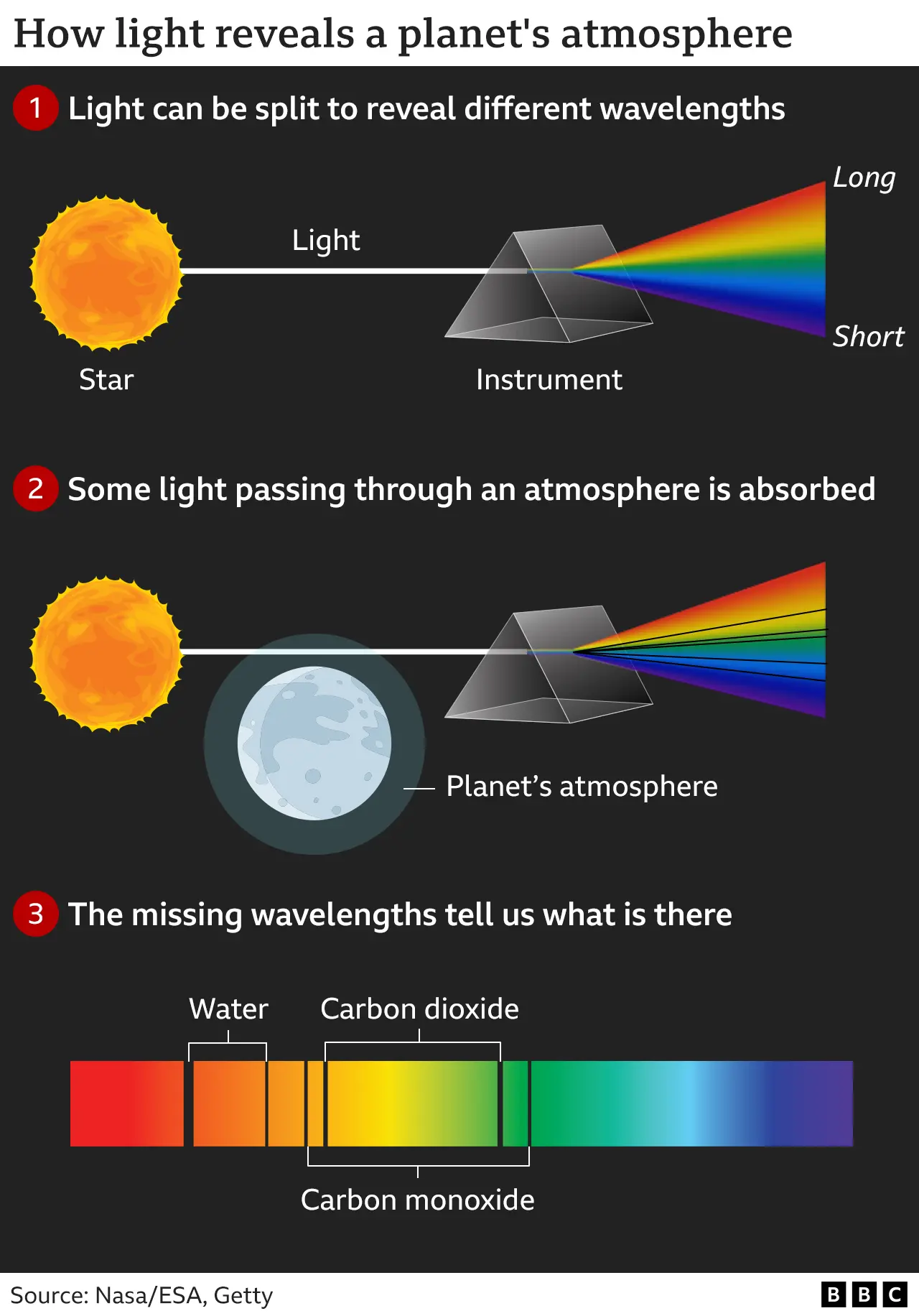Key Takeaways:
- Astronomers are increasingly confident about finding life beyond Earth and are actively searching for signs.
- Telescopes like JWST are finding exoplanets with atmospheres hinting at potential life-supporting conditions.
- Powerful telescopes like ELT and HWO will enable detailed analysis of exoplanetary atmospheres.
- Missions to Jupiter’s moon Europa and Saturn’s moon Titan aim to search for life within our solar system.
- SETI is refining its search for potential alien signals alongside the hunt for biosignatures.
Many astronomers are no longer asking whether there is life elsewhere in the Universe. Instead, they are wondering: when will we find it? Many believe that within our lifetimes—possibly in the coming years—we will find life signs on a distant planet.
Leading a mission to Jupiter, a scientist even goes so far as to say that the absence of life on one of the planet’s icy moons would be “surprising”.
NASA’s James Webb Space Telescope (JWST) is searching for many more worlds after finding intriguing clues of life on a planet outside our solar system.
There is a new space race underway to make the greatest scientific discovery ever, and many of these missions are either underway or soon to launch.
“We live in an infinite Universe, with infinite stars and planets. And it’s been obvious to many of us that we can’t be the only intelligent life out there,” says Prof Catherine Heymans, Scotland’s Astronomer Royal.
“We now have the technology and the capability to answer the question of whether we are alone in the cosmos.”
The ‘Goldilocks zone’
Now that planets are orbiting far-off stars have atmospheres to study, telescopes can search for chemicals that, at least on Earth, can only be made by living things.
Earlier this month, there was a hint of such a discovery. The atmosphere of the planet K2-18b, located 120 light years away, contains what may be the first indication of a gas that is normally produced on Earth by simple marine organisms.
Astronomers refer to the planet’s orbit as “the Goldilocks zone” because it is just the right distance from its star for the surface temperature to be neither too hot nor too cold, but just right for liquid water to exist, which is necessary for life.

In a year, the team hopes to find out if the intriguing hints are real or have vanished.
According to the study’s lead researcher, Prof. Nikku Madhusudhan of Cambridge University’s Institute of Astronomy, “it would radically change the way we think about the search for life” if the hints are verified.
“If we find signs of life on the very first planet we study, it will raise the possibility that life is common in the Universe.”
He believes that our understanding of life in the universe will undergo “a major transformation” in the next five years.
His team has 10 more Goldilocks planets on their list to investigate, and possibly many more after that, if they are unable to discover any indications of life on K2-18b. According to him, even the absence of evidence would “provide important insights into the possibility of life on such planets”.
His search for evidence of life in the universe is just one of several that are underway or scheduled for the upcoming years. While some focus on the planets within our solar system, others extend their search much farther, into deep space.

Despite its strength, NASA’s JWST has its limitations. Because of its size and closeness to the Sun, Earth can support life. However, the glare would prevent JWST from detecting distant planets that are as small as Earth (K2-18b is eight times larger) or as near to their parent stars.
Thus, NASA is preparing for the 2030 launch date of the Habitable Worlds Observatory (HWO). By utilizing an advanced solar shield, it reduces the amount of light coming from the star that a planet revolves around. This implies that it will be able to identify and gather samples from planets that resemble our own.
The Extremely Large Telescope (ELT) of the European Southern Observatory (ESO), which will be located on the ground and gaze up at the pristine skies of the Chilean desert, will also go online later this decade. It can see far more detail at planetary atmospheres than its predecessors because it has the largest mirror of any instrument ever built, measuring 39 meters in diameter.
Utilizing a method that chemists have been using for hundreds of years, all three of these atmosphere-analyzing telescopes are able to identify the chemicals contained in materials based on the light that they emit.
They can accomplish this from the tiny pinprick of light emitted by a planet orbiting a star hundreds of light years away because they are so incredibly powerful.

Searching close to home
Some focus their search on planets that are far away from Earth, while others limit their investigation to the planets in our own Solar System.
One of Jupiter’s icy moons, Europa, is most likely the place where life first began. This world is stunning, with surface fissures resembling tigers’ stripes. Beneath its icy surface, Europa contains an ocean from which water vapor plumes shoot into space.
Early in the 2030s, NASA’s Clipper and the European Space Agency’s Jupiter Icy Moons Explorer (Juice) missions will arrive there.

I asked Prof. Michelle Dougherty, the lead scientist of the European mission, if she thought there was a chance of finding life, shortly after the Juice mission was approved in 2012. She responded, “It would be surprising if there wasn’t life on one of the icy moons of Jupiter.”
Additionally, NASA is aiming to land a spacecraft named Dragonfly on Titan, one of Saturn’s moons. It’s a strange world with lakes and clouds formed of compounds rich in carbon, giving the planet a spooky orange haze. These substances are believed to be essential to life, along with water.
Although Mars is currently too hostile for life, astrobiologists think that the planet was once lush, capable of supporting life, with oceans and a thick atmosphere.
Currently gathering samples from a crater that was formerly believed to have been an ancient river delta is NASA’s Perseverance rover. Those rocks will be brought to Earth in the 2030s as part of a different mission to look for possible microfossils of extinct simple life forms.
Could aliens be trying to contact us?
The hunt for radio signals from alien worlds has been ongoing for decades, not least by the Search for Extra Terrestrial Intelligence (Seti) institute. Some scientists view this question as science fiction territory and a long shot.
Since space is a vast area, their searches have thus far been chaotic. However, Seti can concentrate its search because telescopes like JWST can pinpoint the locations where alien civilizations are most likely to exist.
Dr. Nathalie Cabrol, director of Seti’s Carl Sagan Center for the study of life in the Universe, claims that this has given it new life. The institute has modernised its telescope array and is now using instruments to look for communications from powerful laser pulses from distant planets.
Being a highly skilled astrobiologist, Dr. Cabrol is aware of the skepticism that some scientists have towards Seti’s quest for a signal.
However, Dr. Cabrol contends that chemical signatures from distant atmospheres, intriguing readings from moon flybys, and even microfossils from Mars are all comprehensible.
Looking for a signal “might seem the most far-fetched of all the various approaches to find signs of life. However, it would also be the clearest and most likely to occur at any time.
Dr. Cabrol says, “Imagine we have a signal that we can actually understand.”
There was no proof, thirty years ago, that planets orbited other stars. Since more than 5,000 have now been found, astrobiologists and astronomers can examine them in previously unknown detail.
The team studying K2-18b at Cardiff University, led by Dr. Subhajit Sarker, believes that all the conditions are right for a discovery that will go beyond mere scientific marvels.
“If we find signs of life, it will be a revolution in science and it is also going to be a massive change in the way humanity looks at itself and its place in the Universe.”


